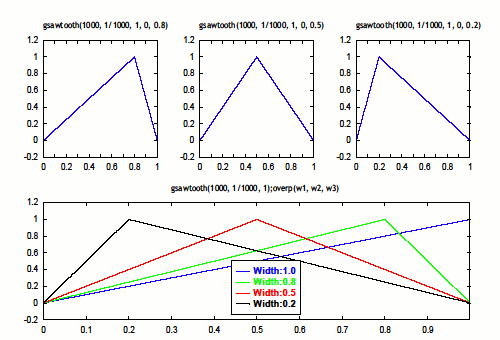
DADiSP Online Help
Click here to see this page in full context

DADiSP Worksheet Functions > Function Categories > Generated Series > GSAWTOOTH
Generates a sawtooth wave.
GSAWTOOTH(length, spacing, frequency, phase, width, duty)
|
length |
- |
An integer, the length of the output series. |
|
spacing |
- |
A real, the spacing (delta x) between each point on the |
|
frequency |
- |
Optional. A real, the frequency specified in cycles per second (Hertz). Defaults to 1. |
|
phase |
- |
Optional. A real, the phase specified in radians. Defaults to 0. |
|
width |
- |
Optional. A real between 0 and 1. The fraction of the sawtooth period where the maximum value occurs. Defaults to 1.0. |
|
duty |
- |
Optional. A real, between 0 and 100. The duty cycle, the percentage of a period the sawtooth is "on". Defaults to 100.0. |
A series.
gsawtooth(1000, 1/1000, 3)
Generates 1000 points of a 3 Hz sawtooth with a sample rate of 1000 Hz. The peak value occurs at the end of each period.
W1: gsawtooth(1000, 1/1000, 4)
W2: gtriwave(1000, 1/1000, 4);overp(w1, lred)
W1 contains 1000 points of an 4 Hz sawtooth with a sample rate of 1000 Hz. W2 contains 1000 points of an 4 Hz triangle wave with a sample rate of 1000 Hz. The overplot provides a graphical comparison.
W1: gsawtooth(1000, 1/1000, 1, 0, 0.8)
W2: gsawtooth(1000, 1/1000, 1, 0, 0.5)
W3: gsawtooth(1000, 1/1000, 1, 0, 0.2)
W4: gsawtooth(1000, 1/1000, 1);overp(w1, w2, w3)
legend(W4, 0.05, 1.1, "Width:1.0", "Width:0.8", "Width:0.5", "Width:0.2")

W1 through W4 contain 1000 points of an 1 Hz sawtooth with a sample rate of 1000 Hz. The width parameter for each sawtooth is set to 0.8, 0.5, 0.2 and 1.0 respectively. The overplot in W4 provides a graphical comparison of the effect of the differing sawtooth widths.
The sawtooth is normalized with an amplitude between 0.0 and 1.0. The leading edge of the sawtooth rises monotonically.
See GTRIWAVE to generate a triangle wave.